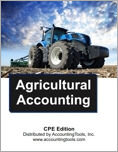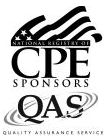Agricultural Accounting (CPE Course)
CPE Credit: 10 hours
Related Courses
Course Type: Downloaded PDF materials with online test
Price (with PDF Textbook): $70
Course Description
Agricultural Accounting addresses every aspect of the accounting that one might encounter in a farm, ranch, or related business. The intent is to not only explain accounting concepts, but also to provide examples and show how an accounting system can be constructed and operated. The course pays particular attention to unique aspects of agricultural accounting that are not encountered in other industries, including special valuation rules for inventory, hedging transactions, dealing with cooperatives, and recording non-current farm assets. In short, this course is an essential desk reference for anyone engaged in agricultural operations.
Author: Steven Bragg
Course Number: AC1108
Table of Contents
Chapter 1. Introduction to Agricultural Accounting
Chapter 2. Accrual and Cash Basis Accounting
Chapter 3. Accounts
Chapter 4. Accounting Transactions
Chapter 5. Receivables Accounting
Chapter 6. Investment Accounting
Chapter 7. Inventory Accounting
Chapter 8. Fixed Assets and Depreciation
Chapter 9. Non-Current Farm Assets
Chapter 10. Payables Accounting
Chapter 11. Debt Accounting
Chapter 12. Income Taxes
Chapter 13. Derivatives and Hedging Transactions
Chapter 14. Cooperative Accounting
Chapter 15. Revenue Recognition
Chapter 16. Financial Statement Preparation
Chapter 17. Financial Statement Disclosures
Chapter 18. Farm Financial Analysis
Learning Objectives
Recognize the different accounting principles.
Cite the line items and classifications used within the financial statements.
Specify the differences between financial and managerial accounting.
Specify the differences between cash basis and accrual basis accounting.
Identify the concepts behind the accrual-adjusted approach.
Specify the types of source documents for an accounting system.
Recognize how assets and liabilities are classified within the balance sheet.
Recognize the structure used in the chart of accounts.
Identify the different types of accounting transactions and how they are recorded.
Describe contra accounts and how they are used.
Specify the methods used to derive the allowance for doubtful accounts.
Describe the different classifications of securities.
Recognize how the other comprehensive income classification is used.
Specify the calculation for the net proceeds from the sale of an investment.
Recognize the issues with using the periodic inventory system.
Identify the calculation for net realizable value and when this valuation can be used.
Identify the components of a depreciation calculation, and how the mid-month convention can be used in calculating depreciation.
Cite the calculations used for the accelerated depreciation methods.
Specify the entry used to record the disposal of a fixed asset.
Identify the investments that are considered to be permanent land developments.
Recognize the costs incurred in the development of non-current assets.
Specify the different types of intermediate-life plants and how their costs are classified.
Recognize the methods used to create supplier identification numbers.
Specify the structure of the Form 1099-MISC and its parts.
Recognize the reasons for reconciling loan accounts.
Cite the circumstances under which a tax position is recognized.
Specify the tax rate used in interim reporting periods.
Specify the process flow for using the other comprehensive income classification.
Recognize the different types of hedging transactions.
Describe the nature of a highly effective hedge and its effect.
Identify the types of cooperatives.
Specify the recognition criteria for patronage refunds and sales to cooperatives.
Recognize the unique aspects of loans from the Commodity Credit Corporation.
Identify the different types of entries used when closing the books.
Identify how the income summary account is used.
Specify the analysis methods used to review preliminary financial statements.
Recognize the different types of disclosures that should be attached to farm financial statements.
Define the different classifications of ratios.
Identify the calculations used for each of the farm analysis ratios.
Level: Overview
Instructional Method: QAS Self-Study
NASBA Category: Accounting
Prerequisites: None
Advance Preparation: None
Latest Review Date: August 2023
Program Registration Requirements: Click on "Purchase Course" near the top of this page to pay for and access the course. You will then be able to download the course as a PDF file, then take an on-line examination, and then download a certificate of completion if you pass the examination.
Program Refund Policy: For more information regarding administrative policies concerning complaints, refunds, and other matters, see our policies page.
AccountingTools, Inc. is registered with the National Association of State Boards of Accountancy (NASBA) as a sponsor of continuing professional education on the National Registry of CPE Sponsors. State boards of accountancy have the final authority on the acceptance of individual courses for CPE credit. Complaints regarding registered sponsors may be submitted to the National Registry of CPE Sponsors through its website: www.nasbaregistry.org.
The NASBA sponsor identification number for Accountingtools, Inc. is 115881.
AccountingTools is an IRS Approved Continuing Education Provider. We are compliant with the requirements for continuing education providers (as described in sections 10.6 and 10.9 of the Department of Treasury’s Circular No. 230 and in other IRS guidance, forms, and instructions). Our IRS Approved Continuing Education Provider number is 72821.


